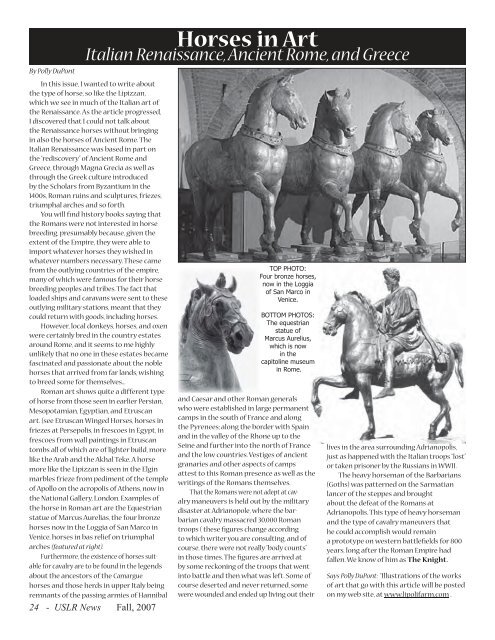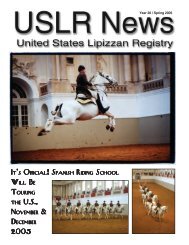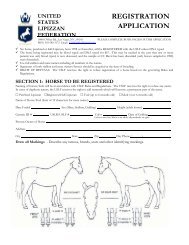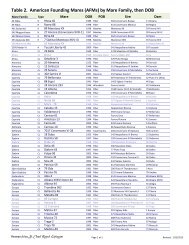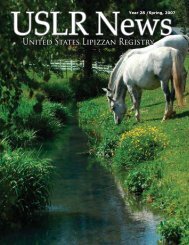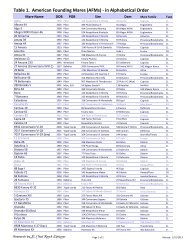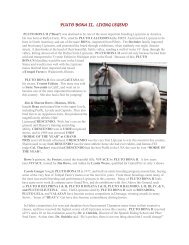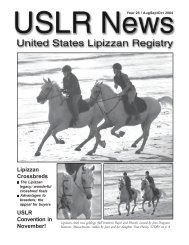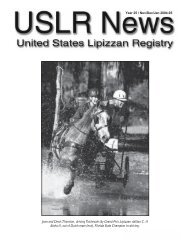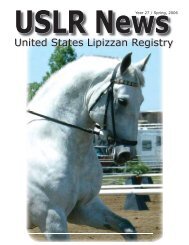Fall 2007 - United States Lipizzan Federation
Fall 2007 - United States Lipizzan Federation
Fall 2007 - United States Lipizzan Federation
Create successful ePaper yourself
Turn your PDF publications into a flip-book with our unique Google optimized e-Paper software.
By Polly DuPont<br />
Horses in Art<br />
Italian Renaissance, Ancient Rome, and Greece<br />
In this issue, I wanted to write about<br />
the type of horse, so like the <strong>Lipizzan</strong>,<br />
which we see in much of the Italian art of<br />
the Renaissance. As the article progressed,<br />
I discovered that I could not talk about<br />
the Renaissance horses without bringing<br />
in also the horses of Ancient Rome. The<br />
Italian Renaissance was based in part on<br />
the “rediscovery” of Ancient Rome and<br />
Greece, through Magna Grecia as well as<br />
through the Greek culture introduced<br />
by the Scholars from Byzantium in the<br />
1400s, Roman ruins and sculptures, friezes,<br />
triumphal arches and so forth.<br />
You will find history books saying that<br />
the Romans were not interested in horse<br />
breeding, presumably because, given the<br />
extent of the Empire, they were able to<br />
import whatever horses they wished in<br />
whatever numbers necessary. These came<br />
from the outlying countries of the empire,<br />
many of which were famous for their horse<br />
breeding peoples and tribes. The fact that<br />
loaded ships and caravans were sent to these<br />
outlying military stations, meant that they<br />
could return with goods, including horses.<br />
However, local donkeys, horses, and oxen<br />
were certainly bred in the country estates<br />
around Rome, and it seems to me highly<br />
unlikely that no one in these estates became<br />
fascinated and passionate about the noble<br />
horses that arrived from far lands, wishing<br />
to breed some for themselves...<br />
Roman art shows quite a different type<br />
of horse from those seen in earlier Persian,<br />
Mesopotamian, Egyptian, and Etruscan<br />
art. (see Etruscan Winged Horses, horses in<br />
friezes at Persepolis, in frescoes in Egypt, in<br />
frescoes from wall paintings in Etruscan<br />
tombs all of which are of lighter build, more<br />
like the Arab and the Akhal Teke. A horse<br />
more like the <strong>Lipizzan</strong> is seen in the Elgin<br />
marbles frieze from pediment of the temple<br />
of Apollo on the acropolis of Athens, now in<br />
the National Gallery, London. Examples of<br />
the horse in Roman art are the Equestrian<br />
statue of Marcus Aurelias, the four bronze<br />
horses now in the Loggia of San Marco in<br />
Venice, horses in bas relief on triumphal<br />
arches (featured at right).<br />
Furthermore, the existence of horses suitable<br />
for cavalry are to be found in the legends<br />
about the ancestors of the Camargue<br />
horses and those herds in upper Italy being<br />
remnants of the passing armies of Hannibal<br />
24 - USLR News <strong>Fall</strong>, <strong>2007</strong><br />
TOP PHOTO:<br />
Four bronze horses,<br />
now in the Loggia<br />
of San Marco in<br />
Venice.<br />
BOTTOM PHOTOS:<br />
The equestrian<br />
statue of<br />
Marcus Aurelius,<br />
which is now<br />
in the<br />
capitoline museum<br />
in Rome.<br />
and Caesar and other Roman generals<br />
who were established in large permanent<br />
camps in the south of France and along<br />
the Pyrenees; along the border with Spain<br />
and in the valley of the Rhone up to the<br />
Seine and further into the north of France<br />
and the low countries. Vestiges of ancient<br />
granaries and other aspects of camps<br />
attest to this Roman presence as well as the<br />
writings of the Romans themselves.<br />
That the Romans were not adept at cavalry<br />
maneuvers is held out by the military<br />
disaster at Adrianopole, where the barbarian<br />
cavalry massacred 30,000 Roman<br />
troops ( these figures change according<br />
to which writer you are consulting, and of<br />
course, there were not really “body counts”<br />
in those times. The figures are arrived at<br />
by some reckoning of the troops that went<br />
into battle and then what was left. Some of<br />
course deserted and never returned, some<br />
were wounded and ended up living out their<br />
lives in the area surrounding Adrianopolis,<br />
just as happened with the Italian troops “lost”<br />
or taken prisoner by the Russians in WWII.<br />
The heavy horseman of the Barbarians<br />
(Goths) was patterned on the Sarmatian<br />
lancer of the steppes and brought<br />
about the defeat of the Romans at<br />
Adrianopolis. This type of heavy horseman<br />
and the type of cavalry maneuvers that<br />
he could accomplish would remain<br />
a prototype on western battlefields for 800<br />
years, long after the Roman Empire had<br />
fallen. We know of him as The Knight.<br />
Says Polly DuPont: “Illustrations of the works<br />
of art that go with this article will be posted<br />
on my web site, at www.lipolifarm.com .


